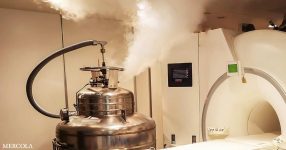
What Happens in Medicine When We Run Out of Helium?
For close to 100 years, the U.S. government has been the largest helium provider worldwide.1 This is set to change, now that the Federal Helium Reserve has been sold to the highest bidder — Messer, an industrial gas company. But with helium already in short supply, the sale has spooked the health care industry amidst fears the helium shortage may get worse.
This isn’t just a matter of party balloons going flat. Helium, the coldest element on Earth, is necessary to keep most magnetic resonance imaging (MRI) machines cool. Without helium — in many cases up to 1,800 liters that must be constantly replenished2 — many MRI machines will cease to function, as will the potentially lifesaving images they provide.
The Cliffside Gas Plant sits on just over 8 acres of land near Amarillo, Texas.3 The facility, which is currently overseen by the U.S. Bureau of Land Management, accounts for up to 30% of the U.S. helium supply, or 9% of the global supply.4 The helium exists about 3,000 feet underground, in a natural geologic formation called the Helium Storage Reservoir.
Why Did the US Sell Its Federal Helium Reserve?
Also known as the Bush Dome, the reservoir has held up to 44 billion cubic feet (Bcf) of helium but, at the time of sale, the U.S. General Services Administration says it’s estimated to contain “approximately 4 plus Bcf of proven and prospective federally owned helium (native and reserve), approximately 2 Bcf of privately owned helium, along with approximately 60 Bcf of federally owned natural gas.”5
The sale of the Federal Helium Reserve was mandated in 1996 to help reduce national debt. According to The National Academies Press:6
“Helium has long been the subject of public policy deliberation and management, largely because of its many strategic uses and its unusual source — it is a derived product of natural gas and its market has several anomalous characteristics.
Shortly after sources of helium were discovered at the beginning of the last century, the U.S. government recognized helium’s potential importance to the nation’s interests and placed its production and availability under strict governmental control.
In the 1960s, helium’s strategic value in Cold War efforts was reflected in policies that resulted in the accumulation of a large reserve of helium owned by the federal government … the Helium Privatization Act of 1996 (1996 12 Act) … directs that substantially all of the helium accumulated as a result of those earlier policies be sold off by 2015 at prices sufficient to repay the federal government for its outlays associated with the helium program.”
A pricing detail in the law dictated that the Bush Dome helium be sold at a price that increased along with the inflation rate — rather than at market prices. But demand for helium soon skyrocketed not only for use in health care but also for the manufacture of semiconductors used for smartphones, automobiles and more. This, Texas Monthly reported, triggered the start of helium shortages:7
“With this and other helium-hogging technological advances, the demand for the gas skyrocketed, as did its price everywhere other than Cliffside. So a handful of companies made big profits buying grossly undervalued helium from the government and reselling it. The amount of helium in the Bush Dome dwindled from about 30 billion cubic feet to 7.6 billion by April 2017.
This cheaply available supply also discouraged companies from seeking new sources of the gas, according to Bo Sears, author of ‘Helium: The Disappearing Element’ and president of Helix Exploration, a minerals exploration company. ‘It is this formula of pricing that has caused all of the shortages that we see today,’ he [said].”
The Helium Stewardship Act of 2013 addressed the pricing problem so the helium would be sold to the highest bidder.8 While a percentage of helium in the Bush Dome has been auctioned off annually since, the last of the helium reserve was sold January 25, 2024.9
Are Helium Supplies Dwindling?
Now that the U.S. stockpile of helium has been sold, fears of further supply shortages have surfaced. In an email to NBC News, a spokesperson for the U.S. Interior Department stated, “Sale of the reserve to a private party, as Congressionally mandated by law, is not expected to meaningfully change the availability of helium.”10
But Soumi Saha, the senior vice president of government affairs at Premier Inc., which connects helium suppliers with U.S. hospitals, told NBC News, “… [W]e are stressing about this shortage. From a health care perspective, MRI machines are the No. 1 concern.”11 For an element that’s the second most abundant in the universe, helium is surprisingly rare on Earth. According to the American Chemical Society (ACS):12
“On the Earth, most helium is a radioactive decay product of uranium and thorium. It is found under the Earth’s crust with other natural gases. Commercial helium is extracted from natural gas when the helium concentra on is above 0.3%.
The U.S., Qatar and Algeria have the world’s major helium reserves, while the U.S., Russia and Algeria are the top suppliers. In the U.S., helium is found primarily in the Texas panhandle and Kansas. Uncertainty about how private markets will distribute and price helium is a concern, especially to scientific researchers using small amounts of helium.”
ACS describes helium as an “endangered element,” since it’s the only unrecoverable element. When helium is released, it rises until it gets to space, so “atmospheric recovery of helium is nearly impossible.”13 Liquid helium that boils off can be captured and recycled, but recycling infrastructure in the U.S. is limited.14 Texas Monthly explains:15
“Helium is so light that it’s not held by the earth’s gravitational pull; it escapes our atmosphere and into space if it’s not contained by rocks or human ingenuity. We have no means of artificially making it, and its natural production — a byproduct of the radioactive decay of elements such as uranium and thorium deep in the earth’s crust — requires hundreds of millions of years.”
3 of 5 Helium Suppliers Are Rationing It
Already, NBC News reports that 3 of 5 U.S. helium suppliers have taken to rationing helium so “life-or-death uses like MRI machines” take priority over parade and party balloons. Scientists using magnetic imaging for research are already feeling the pinch, with some helium suppliers cutting off their allocations. Other specialty scanners could also be affected. According to NBC:16
“For instance, the University of California has a powerful helium-reliant magnetoencephalography, or MEG, scanner, that doctors use to plan pediatric brain operations. Statewide, [University of California’s chief procurement officer Paul] Williams said, there were only two of these scanners.
‘If it runs out of helium, it will require multiple weeks to recool, delaying surgeries, or, in some circumstances, compelling surgeons to operate without detailed brain maps,’ he said, adding that the MEG scanner has barely averted shutdown dozens of times over the past 10 years.”
Additional hurdles, including geopolitical factors, shipping and supply chain issues,17 also abound. Then there’s the fact that liquid helium evaporates after 35 to 48 days — a serious concern when helium must be sourced from outside the U.S. or Canada.18
“Shutting down the U.S. helium reserve would force a situation where we would have to increase our reliance on foreign sources, like Qatar and Russia,” Saha told NBC News. “Given the ongoing geopolitical concerns and tensions in those regions and shipping delays, it would increase concerns around potential shortages on U.S. soil.”19
MRI Machines Depend on Helium for Cooling
Conventional MRI machines depend on extreme cold to keep their magnetic current superconductive.20 Superconductivity, LBN Medical, a reseller of medical imaging equipment, explains, “is the physical effect that occurs in different materials when exposed to extremely low temperatures. It allows the electrical current to flow through the electrical conductor without generating electrical resistance, which results in zero power losses.”21
Helium gets the job done, cooling MRI machines’ superconducting magnets to -269 degrees C. As LBN Medical notes:22
“In order to function, MRI scanners require a coolant that will give the magnetic coils in the scanner superconductive properties. That allows the electrical current to flow through the low resistance coils, enabling the generation of high-intensity magnetic fields … Liquid helium is the perfect element — cold enough to provide the levels of superconductivity required in MRI scanners.”
Unfortunately, helium is not only affected by supply issues but also pricing fluctuations. “The cost of helium has increased 250% over the last five years, making scientific research more expensive. The helium market is subject to frequent price shocks. In 2017, the blockade of Qatar suddenly removed 30% of the world’s helium supply from the market, causing prices to temporarily skyrocket,” ACS reported.23
Previously, reserves from the federal helium reserve could be released to help buffer these types of market upsets, so its sale may add even more “uncertainty and volatility to the market,” University of New Mexico economist Janie Chermak told Science.24 When the reserve changes hands it could also lead to a supply disruption or complete shutdown. Science reported:25
“Looming problems there include a maintenance backlog and the need for the new owner to secure rights of way for 680 kilometers of pipeline, which will not automatically transfer.
There is also the matter of negotiating a new contract with the Cliffside Helium Enrichment Unit — a privately owned facility that is necessary for processing helium at the reserve. For these reasons, the industrial gas company Air Products filed a lawsuit against the government in September arguing that the sale was unlawful.”
Anticipating a potential future without the free use of helium, MRI manufacturers have come out with machines that use far less helium — just 1 to 7 liters — as well as those that use none at all. Still, many hospitals are reluctant to upgrade their equipment, including costly MRI machines that could last for decades.26
Further, it’s not only MRI machines that depend on helium. Nuclear reactors and rockets, as well as the manufacture of fiber optics and semiconductors, also use helium, which is why running out of helium would have global repercussions.
While scientists explore alternatives to hydrogen for a number of applications, ACS recommended that, in order to save helium, chemists can work to increase recycling infrastructure while individuals can stop buying helium balloons.27






